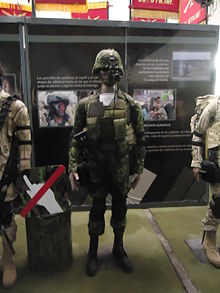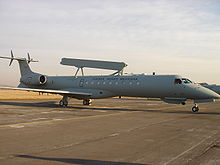Mexican armed forces
|
|||
| guide | |||
|---|---|---|---|
| Commander in Chief : | Andrés Manuel López Obrador | ||
| Military strength | |||
| Active soldiers: | 270,000 (2020) | ||
| Reservists: | 82,000 (2021) | ||
| Conscription: | Yes | ||
| Eligibility for military service: | 18 years | ||
| Share of soldiers in the total population: | 0.20% | ||
| household | |||
| Military budget: | $ 4.38 billion (2021) | ||
| Share of gross domestic product : | 0.5% (2019) | ||
| story | |||
| Founding: | 1821 | ||
The Mexican Armed Forces ( Spanish: Fuerzas Armadas de México ) are the military associations of the United Mexican States .
organization
The Mexican armed forces are divided into the
-
Army (
 - Ejército Mexicano ), which, together with the Air Force (
- Ejército Mexicano ), which, together with the Air Force (  - Fuerza Aérea Mexicana ), is subordinate to the Secretaría de la Defensa Nacional , and the
- Fuerza Aérea Mexicana ), is subordinate to the Secretaría de la Defensa Nacional , and the -
Marine (
 - Armada de México ), which is subordinate to the Secretaría de Marina .
- Armada de México ), which is subordinate to the Secretaría de Marina .
Both secretariats are headed by a general ( admiral ) with the rank of minister. The highest commander in chief of the armed forces is the Mexican president.
There are also other military units such as B. the Presidential Guard and various counter-terrorism units that have their own lines of command.
Conscription is compulsory in Mexico ( Servicio Militar Nacional ). All male residents over 18 are required to do military service , which lasts twelve months. At the age of 16 the service can be started voluntarily, women can also serve voluntarily. The army consists of 270,000 soldiers, of which 200,000 belong to the army, 60,000 to the navy and 8,000 to the air force. There are also 82,000 reservists and 60,000 members of paramilitary units. Military spending in Mexico was 0.5% of gross domestic product in 2019.
story
On September 15, 1810, the struggle for Mexican independence began. The leading figures in Mexico's struggle for independence were Father José María Morelos , Vicente Guerrero , the Spanish General Agustín de Iturbide and General Antonio López de Santa Anna . The fight lasted eleven years until the troops of the Liberation Army entered Mexico City in 1821. The troops of the Liberation Army formed the basis of the Mexican military.
The history of Mexico was changeable and marked by military conflicts. The First Empire was followed by the First Republic (1824–1864). The Mexican-American War from 1846 to 1848 was decided by a landing at Veracruz (March 1847) and the occupation of Mexico City by US troops (September 1847). With the Treaty of Guadalupe Hidalgo (February 2, 1848) Mexico lost more than half of the Mexican national territory to the USA. The presidency of Benito Juárez , which lasted from 1861 to 1872, was interrupted by the Second Empire under Emperor Maximilian I from 1864 to 1867. The Second Republic lasted from 1867 to 1910. 1910 was the beginning of the Mexican Revolution (Revolución Mexicana). The federal army was defeated by various revolutionary groups, led by Emiliano Zapata in the south and Pancho Villa and Pascual Orozco in the north . The dictator Porfirio Díaz resigned on May 25, 1911 "in the name of the peace of the nation" and went into exile in France, where he died in 1915. Venustiano Carranza , a former revolutionary general, enacted a new constitution on February 5, 1917, which is still in force in Mexico today.
The Mexican military is subordinate to the Secretaría de la Defensa Nacional (SEDENA), which was founded in 1884 as the War and Navy Secretariat ( Secretaría de Guerra y Marina ). In 1937 it was renamed Secretaría de la Defensa . Since then, the Secretaría de Marina (SEMAR) has been responsible for the Mexican Navy, the Armada de México . The armed forces follow the tradition of the Mexican War of Independence . They have a reputation for being politically neutral and less prone to corruption than other state institutions and authorities. In contrast to the situation in many other Latin American countries, the Mexican military did not interfere in economic and political transformations. It never acted independently, but only got involved on the orders of the president or the governors.
Until recently, the military was visible after the military conflicts in the 19th century, mainly as a result of natural disasters. But there were also other domestic operations, such as the suppression of the railway strike in 1959, the suppression of the student protests in 1968 and the fight against the guerrillas in the 1970s. In the 1980s and no later than the 1990s, pressure from the United States and the increasing level of drug-related crime led to interventions against the cartels. It turned out that the military could not contain the drug trade, but was increasingly susceptible to corruption by the Narcos. Under President Calderón, the military has been increasingly deployed to combat the drug mafia since the beginning of 2007 in the war declared on the drug cartels .
In the drug war , police and military units are deployed against the criminal organizations involved in drug trafficking (so-called Mexican drug cartels ). Since 2006, the drug war has claimed over 70,000 victims. In 2010, the Heidelberg Institute for International Conflict Research reassessed the conflict as an internal war . The new operational situation led to changes in the Mexican military. It increasingly loses reference to the Mexican Revolution , performs more and more police tasks, is increasingly entangled in human rights violations and is increasingly subordinate to the security interests of the USA. Some Mexican soldiers also undergo US training.
equipment
army
The inventory of the Mexican Army shows a large number of different types of weapons and equipment, some of which are out of date. It has, inter alia. above
- 237 scouts, 4 of them for training purposes
- 706 armored personnel carriers, including 409 modified AMX-13 tanks ( AMX-VCI ), and numerous light transport tanks , mainly from French production such as the Véhicule Blindé Léger .
- 1390 artillery pieces
- More than 1225 anti-tank units
- 80 air defense units
air force
With 11,770 members in relation to the country's population, it is one of the smaller air forces in Latin America; their equipment - especially their fighter jets - are out of date.
-
Warplanes
- 8 Northrop F-5E "Tiger II" , fighter / fighter-bomber
- 60 Pilatus PC-7 , advanced trainer and light ground attack aircraft
-
Reconnaissance aircraft
- 1 Embraer R-99A (EMB-145SA AEW & C) , early warning aircraft
- 2 Embraer P-99 (EMB-145MP) , maritime reconnaissance aircraft
- 4 Fairchild Metro III , reconnaissance aircraft
-
Transport aircraft
- 1 Boeing 787-8 , VIP transport (government aircraft)
- 6 Boeing 727 , transport aircraft
- 10 IAI Arava 101/102/201
- 7 Lockheed C-130E / K / L-100 Hercules , tactical transport aircraft
- 5 Airbus Military C-295 , light transport aircraft
- 4 Alenia C-27J Spartan , light transport aircraft
- 1 Douglas DC-9 , transport aircraft
- 5 Beechcraft King Air 90 , liaison aircraft
- 4 Pilatus PC-6 , short take-off multi-purpose aircraft
- 4 Aero Turbo Commander , liaison aircraft
-
Combat and transport helicopters
- 2 Aérospatiale AS532 Cougar , medium-weight transport helicopter
- 12 Eurocopter EC725 Cougar , multi-purpose helicopter
- 55 Bell 206 , liaison helicopter
- 28 Bell 212/412 , transport helicopter (1 additional ordered)
- 4 Sikorsky CH-53 Sea Stallion , medium-weight transport helicopter
- 22 MD 530 , light attack and reconnaissance helicopter
- 30 Mil Mi-8/17 , transport helicopter
- 1 Mil Mi-26 , heavy transport and multipurpose helicopter
- 6 Sikorsky S-70A , transport helicopter
- 7 Aérospatiale SA330 Puma , transport helicopter
-
Training aircraft and helicopters
- 2 F-5F, combat trainer
- 46 Aermacchi SF-260 , basic trainer
- 28 Pilatus PC-7, advanced trainer (to be replaced by T-6C +)
- 2 Pilatus PC-9 , advanced trainer
- 12 Beechcraft T-6 C +, advanced trainer
marine
The Navy has
- 2 training ships: 1 destroyer , 1 sailing training ship ( Cuauhtémoc ),
- 7 frigates ,
- 127 patrol boats (including numerous corvettes ) and
- 2 amphibious vehicles.
Marine infantry
The Marine Infantry ( Fuerza de Infantería de Marina ) has
- 29 armored personnel carriers and
- 122 artillery pieces.
Naval aviators
The naval aviators ( Fuerza AeroNaval ) have
- 7 air surveillance aircraft,
- 6 coastal patrol aircraft,
- 23 transport aircraft,
- 15 training aircraft,
- 4 rescue helicopters and
- 52 Transport and multipurpose helicopters.
Coast guard
The Coast Guard ( Búsqueda y Rescate Marítimo ) has various lifeboats .
See also
Other paramilitary units
- Federal Police ( Policía Federal ): 13 transport planes, 24 transport helicopters, 3 multipurpose helicopters, 2 drones, 35 helicopters for combating drugs
- Cuerpo de Defensa Rural (activated if necessary)
Web links
- Official website of the Secretaría de la Defensa Nacional (Spanish)
- Official website of the Secretaría de Marina (Spanish)
Individual evidence
- ^ CIA - World Factbook - Countries - Mexico - Military and Security. Accessed February 5, 2021 .
- ↑ Global Firepower. Accessed February 5, 2021 .
- ↑ Global Firepower. Accessed February 5, 2021 .
- ^ CIA - World Factbook - Countries - Mexico - Military and Security. Accessed February 5, 2021 .
- ↑ Information on the military in the CIA World Factbook on cia.gov, accessed July 16, 2011
- ^ Mexico - The World Factbook. Retrieved February 5, 2021 .
- ↑ 2021 Mexico Military Strength. Retrieved February 5, 2021 .
- ↑ a b Klaus Stüwe (ed.) And Stefan Rinke (ed.): The political systems in North and Latin America. An introduction. VS Verlag für Sozialwissenschaften, Wiesbaden 2008, p. 402.
- ↑ Conflict Barometer 2010. (4.8 MB) (No longer available online.) HIIK, September 6, 2010, archived from the original on September 13, 2011 ; accessed on May 18, 2011 (English, pdf, p. 50ff.). Info: The archive link was inserted automatically and has not yet been checked. Please check the original and archive link according to the instructions and then remove this notice.
- ↑ a b BICC: Information Service Security, Armaments and Development in Recipient Countries of German Armaments Exports - Country Portrait Mexico ( Memento of the original dated August 11, 2014 in the Internet Archive ) Info: The archive link has been inserted automatically and has not yet been checked. Please check the original and archive link according to the instructions and then remove this notice. , Bonn, 2014
- ↑ Regierungsjet for Mexico: Dreamliner with luxury interior - aero telegraph. In: aeroTELEGRAPH. Retrieved April 12, 2016 .





